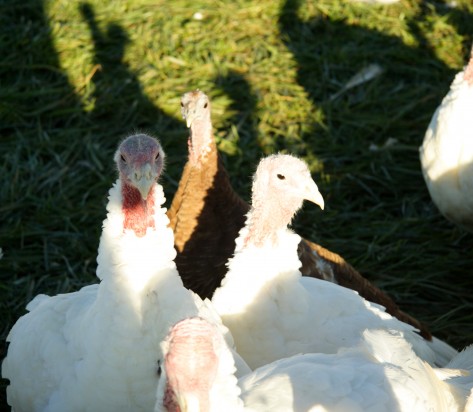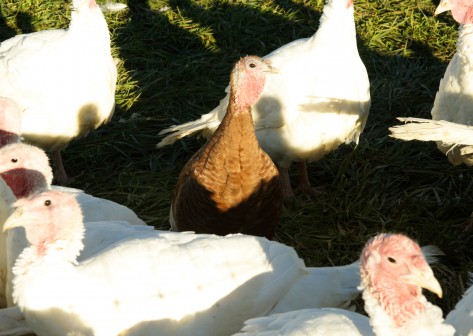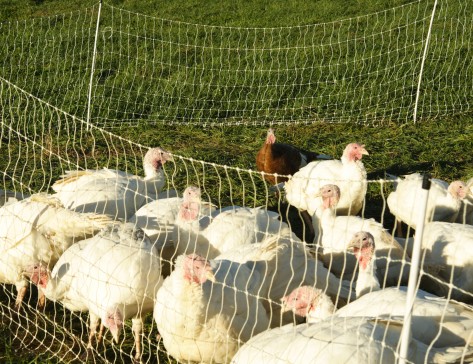The Not Pardoned Turkey

Last Friday the 13th, on a mild, blue-skied mid-November afternoon, I took a drive out to Keenbell Farm. Fridays are the Farm Store day at the farm, and are a good time to catch C.J. Isbell. The purpose of my trip was to run a couple of embryonic story ideas past C.J. and to check up on my pardoned turkey, a Bourbon Red hen who will remain nameless. Of course she is not “my” turkey, but upon hearing her story, I was immediately taken with this feisty broad who managed to escape the dinner table fate of her colleagues. Somehow I felt invested in telling her story for the Thanksgiving holiday, and I was curious to know how she was getting on.
C.J., co-owner of Keenbell Farm with his father, Eddie, had relayed the story to me in late August during a farmyard walkabout. (I was there to interview him about Keenbell Farm for a story published in the Nov/Dec issue of Edible Richmond Magazine.) During the tour C.J. introduced me to some of the farm’s outliers: Mimi, a fainting goat; Charley and Ritzy; two riding horses; and an escapee Bourbon Red turkey who moved so quickly I could hardly catch sight of her. Undoubtedly lonely but glad to be alive, she was the sole survivor from the Isbell’s trial flock of forty-five turkeys, which had been processed more than a month earlier.
The Isbells chose Bourbon Reds because they prefer to work with heritage breeds whenever possible. (Their beef cattle, hogs, and laying hens are all heritage breeds.) Unlike their commercial counterparts, Bourbon Red turkeys still have some traits of their wild cousins: They roost in high spots at night and they can fly up to 35 feet in the air, a useful skill when trying to evade the hangman.
Unfortunately, the Bourbon Reds did not turn out to be a viable option, financially, for the Isbells. Heritage animals are more costly to raise than commercial breeds: They can be more expensive to purchase (the cost of Bourbon Red chicks is about twice as much as a commercial breed), they tend to put on weight more slowly than commercial breeds, and, in the case of poultry, never get as big and meaty as their commercial counterpart.
The higher cost of raising heritage breeds isn’t a problem if you can pass it onto your customer. But, with poultry this is a particularly hard sell. Overwhelmingly, Keenbell Farm customers’ response to the Bourbon Reds wasn’t favorable—most everyone said “we’re looking for a bigger bird” or “we like more breast meat.”
Truth is, we have become accustomed to large, meaty poultry with lots of tender breast meat, and we’ve become used to thinking of poultry (certainly chicken) as an inexpensive, everyday meat. Heritage poultry has proportionally more dark meat to white and the meat is firmer, often requiring cooking techniques such as brining, marinating, or stewing to get good results. (Click here to read about my own learning curve in cooking heritage poultry.)
For these reasons—cost of production and the pricing the market will bear—the Isbells lost money on the Bourbon Reds. They felt they simply couldn’t charge what they needed to charge for a product that most customers were not in love with in the first place. The Isbells switched to the Broad Breasted White, the standard breed used by large commercial turkey producers. This is the bird that graces almost all Thanksgiving tables today (think Butterball). The Isbells purchased 100 chicks in early July to have them ready for processing in time for the Thanksgiving holiday.
A couple of weeks after my initial outing to Keenbell Farm I returned to confirm a few details for the Edible Richmond Magazine story and to buy some of their excellent grass-fed beef. And to get the latest on the escapee hen. CJ told me that since I’d been out last, the hen had taken up with the Broad Breasted Whites; she had jumped right into the mobile turkey tractor that housed the younger turkeys. Because the Bourbon Red was bigger than the Broad Breasted Whites, they got along famously. (Normally a bird entering an existing flock, and particularly one that does not look like the others, will not be easily accepted.)
Fast forward to my mid-November visit, a week before the planned turkey processing day for the Thanksgiving holiday, and the Broad Breasted Whites were noticeably larger than the Bourbon Red. As C.J. and I approached the turkeys, they ran toward us, expecting food, I suppose, or anticipating being moved to a fresh patch of delicious grass, worms, insects, and such. As we stood there, with the pleasantly warm sun on our backs, the turkeys seemed to move in a collective wave, back and forth, as did their cackles and gobbling, moving up in a crescendo and then down again. At the center of the flock, was my pardoned hen. I looked at her and she looked at me, and I swear I detected a look of calm, assured well-being in her eye. Maybe that came from being a surrogate mother hen to the Broad Breasted Whites that had outgrown her. Or maybe that was because she, as I had, assumed she had a good chance of remaining a farmyard turkey indefinitely, seeing as she was not a financially viable breed.
“Do you think she looks so peaceful because she knows she isn’t going to be butchered with the rest?” I asked C.J.
“Oh, she’ll be processed at the same time as the others,” C.J. replied.
What? My mind reeling with this sudden turn of events, I noted, thinking out loud, “Oh, then I’ll have to change the title of my blog posting. I can’t call it the story of the pardoned turkey, anymore.”
Pause.
Then, effortlessly, without missing a beat, I went from being an advocate for the pardoned to being an accomplice to the executioner.
“Can I have her, then?” I asked.
As long as someone is going to eat her, I thought, it might as well be me. How often do you get the chance to prepare and eat a Heritage turkey that’s been walking around this earth for six-plus months? Just imagine how much flavor she’ll have. Now I was truly invested in her: all 10 pounds of her at $4.50 a pound.
Why not just let her be? As a farmyard feathered friend? Birds, C.J. explained are very social. Our Bourbon Red would be unhappy without her flock and because she can fly, she’d be off into the woods before you know it, where she’d probably become prey to a coyote. “And then,” C.J. said, “nobody would get to enjoy her.” Of course, the coyote might enjoy her, I mused to myself. But if it’s between me and the coyote, I choose me.
If she manages to escape once again on the scheduled day of processing, I wish her well. If she doesn’t, expect a follow-up story about her date with my dinner table.


Note: Keenbell Farm’s fresh, pasture-raised turkeys are all spoken for this year. But the Isbells will increase the number of turkeys they raise for next Thanksgiving, and they plan to have turkey available at other times of the year as well.

Wile E. Turkey! If anyone could outsmart those coyotes it would be her!
1You’re right. Those heritage breeds have more smarts about them than than today’s breeds destined for one-dimensional factory farm life. You know, I never did get that turkey . . .
2